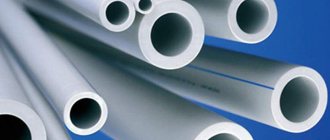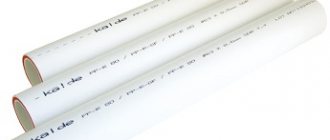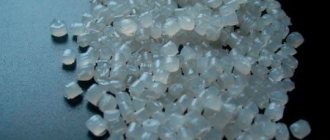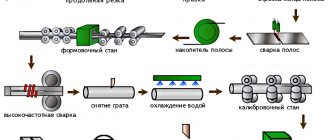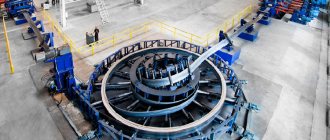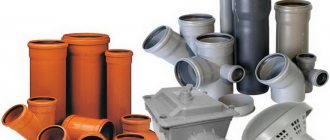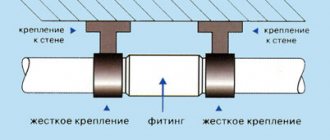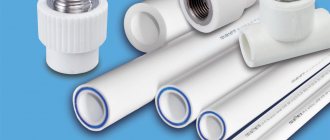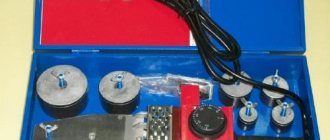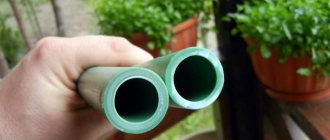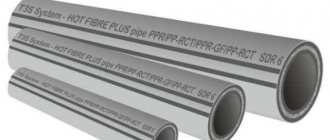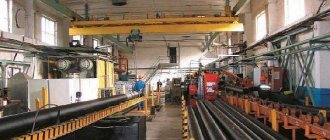LAMMIN LLC is one of the largest manufacturers of polypropylene pipes and fittings in Russia, a member of the Chamber of Commerce and Industry of the Vladimir Region and is a member of the Association of Pipeline Systems Manufacturers.
The plant was put into operation in January 2021 - the management decided to take a course towards import substitution and filling the market with high-quality Russian-made products. In terms of the volume of products produced, LAMMIN is currently one of the top ten manufacturers of polypropylene pipes and fittings.
Today the plant produces:
- pipes, fittings and shut-off valves made of polypropylene for pressure water supply and heating from Ø20 to Ø110mm;
- PE-RT pipes for water supply, underfloor heating systems and high-temperature heating;
- HDPE pipes for cold pressure water supply, for external and internal networks with a diameter from Ø20 to Ø110 mm, made of PE100, supplied in coils and sections.
Market of polypropylene pipes: range and leaders
The market for polypropylene products for pipelines today is represented by both Western giants, which have already proven themselves, and companies operating in the post-Soviet space; a significant share of the Russian market belongs to domestic and Chinese manufacturers.
Undoubtedly, all experts recognize German companies as leaders in this industry. The Czechs are slightly inferior to them. Turkish manufacturers offer competitive prices and high quality.
Against this background, Russian, Ukrainian companies and manufacturers from Belarus and Kazakhstan, although weaker, are not inferior in their desire to make quality products.
At the end of the rating list are Chinese companies whose products are famous for their low quality pipe products. The exception, perhaps, is a subsidiary of the UK manufacturer Blue Ocean and the Chinese company Dyzain.
Business registration
The choice of the organizational and legal form of a future enterprise for the production of plastic pipes depends solely on the owner of the business and his future plans.
If an entrepreneur plans to supply products only to nearby regions of Russia, then it will be enough to register an individual entrepreneur. To export goods abroad, it is best to choose an LLC.
The taxation system is selected in accordance with the chosen legal status.
OKVED codes:
- 22 – Production of rubber and plastic products;
- 2 – production of plastic products;
- 76 – Wholesale trade of other intermediate products.
The production of PVC pipes must be carried out in accordance with Russian (GOST 18599-2001) and international (EN 12201-2:2011) standards. Considering that polymers are used to produce pipes, which release toxic and toxic substances when heated, therefore production will be considered harmful. This means that the entrepreneur will have to contact the relevant supervisory authorities that monitor compliance with environmental legislation.
Review of brands
In the Russian Federation, on the polypropylene pipe market you can find products from a number of manufacturers, which are conventionally classified into four main categories:
- flagship German products are offered by Rehau, Banninger, Aquatherm, Wefatherm, certified according to European standards;
- Czech brands Ekoplastik and FV-Plast, which provide a guarantee of over 15 years and offer pipes at an affordable price;
- Turkish Kalde, Pilsa, TEBO, SPK, FIRAT, Romanian Valtec - do not provide a long warranty, but practice product testing;
- Russian pipes produced in the CIS. Enterprises operate on the basis of licenses from foreign manufacturers.
We recommend that you read: Differences and areas of application of polyethylene and polypropylene
QUALITY CONTROL LABORATORY
The Moscow FDplast plant has its own modern laboratory for product quality control.
The quality control department (QCD) carries out quality checks during production of products, when they are shipped to the warehouse, and when shipped to the client. A technical passport is drawn up for each batch indicating the actual physical and mechanical parameters of the pipe.
The compliance of manufactured products with Russian standards is confirmed by certificates of the State Standard of Russia. The hygienic properties of pipes and fittings manufactured at the Moscow FDplast plant are confirmed by a certificate from the State Committee for Sanitary and Epidemiological Surveillance of the Russian Federation (SanPiN 2.1.4.1074-01).
Market leaders
First-tier companies produce PP pipes with a long warranty.
Flagship positions are traditionally represented by the companies Rehau, Banninger, Aquatherm, Wefatherm. Their products are not just quality, but are backed by scientific research and made from materials originating from the company's research and development laboratories. The cost of such systems is higher.
Aquatherm Company
- 10-year warranty, service life – within 50 years;
- to satisfy possible claims, the company has established a liability limit of 8 million euros;
- no glue or sealants are used during installation; the pipes are assembled together using the press-fit method, ensuring complete tightness of the system;
- the inner surface is perfectly smooth and does not affect the circulating fluid;
- operating temperature 95°C, a short-term increase to higher values is possible, but to compensate for the operation of a solid fuel boiler, it is recommended to use an intermediate tank.
Rehau Rautitan
- For installation, a sleeve is used that secures the connection using the crimping method, as well as fastenings without threads. The connecting elements are made of specialized material PPSU;
- wide size range 16-63 mm, pipes belong to the category of reinforced polyurethane PE-X/Al/PE, the inner layer is made of cross-linked polyethylene PE-X, which ensures high hygiene;
- it is permissible to use water pipes for heating;
- the connection can be directly connected to the heating system;
- shaped parts do not form cracks;
- an additional set of components is proposed;
- a special polymer material is used – high-strength cross-linked polyurethane;
- the company offers professional installation tool Rautool for welding manufactured pipes.
Banninger
- PP-RCT pressure systems are offered, developed in the company's research and development center, which have reduced weight.
These pipes are characterized by the absence of wall resistance in relation to the moving liquid, which allows for improved energy saving characteristics in heating circuits;
- impeccable raw materials are used;
- strict quality system.
Wefatherm
- products are manufactured from copolymer polypropylene;
- service life up to 50 years;
- temperature up to 70°C, short-term rise to 100°C is allowed;
- impeccable hygiene;
- pipes have thermal insulation properties.
We recommend that you read: Is metal-plastic or polypropylene better for plumbing?
Turkish and Czech manufacturers of PP pipes
Kalde, Pilsa, TEBO, SPK, FIRAT, Romanian Valtec produce high quality products.
Products are tested in three stages and comply with the declared characteristics.
The quality level of these pipes is very high and suits most consumers. Despite the lack of a long-term warranty, when selecting the characteristics of the system, they will easily last about 50 years.
Russian factories producing PP pipes
Russian manufacturers of polypropylene pipes work using licensed technology purchased from Italian, Czech and German companies. Among the company's manufacturers are: FD Plast, YarInterPlast, Magistral Plast and others.
Equipment for the production of
To produce high-quality, competitive products, the enterprise is equipped with modern technological equipment for casting polypropylene pipes and fittings, which allows the production of products for creating household, industrial water supply and heating systems:
- 4 high-tech extrusion lines for the production of polymer pipes can produce from 480 tons per month. European equipment of extruders (ABB motors and frequency converters and SIMENS electronics), increased length and a modern cooling system allow achieving maximum productivity - up to 27 m/min.
- 8 injection molding machines with clamping forces from 320 and 380 tons for the production of a wide range of injection molded fittings.
- High-tech hot runner molds from a leading Turkish manufacturer with a production resource of up to 1 million clamping cycles.
- Own turning workshop for maintenance and repair of molds, which ensures an uninterrupted production cycle.
- A modern system for unpacking, drying and centralized supply of raw materials to extruders and injection molding machines allows for maximum optimization of production costs and reduction of production costs.
Modern HAITIAN injection molding machines are capable of producing polypropylene fittings and fittings of any shape (angles, tees, crosses, etc.) weighing up to 1 kg and volume up to 0.3 m³. About 800 (eight hundred) tons of polypropylene products are produced monthly, not inferior in quality to their European counterparts.
[edit] History
[edit] USSR
Main article
:
Polypropylene production in the USSR
A feature of the petrochemical industry in the USSR was the weak development of polypropylene (PP) production. The first domestic industrial processes of propylene polymerization were carried out on Ziegler-Natta catalysts in a hydrocarbon solvent. In 1965, a domestic semi-batch industrial process for producing PP in liquefied propanepropylene fractions or liquid propylene was introduced at the Moscow Refinery. Design capacity is 10 thousand tons of polymer per year.[4]
The next step in the development of the domestic polypropylene market was the launch in 1977 of production in Guryev (Kazakh SSR) using technology from Mondison (Italy). In 1982, using the same famous Italian technology, a plant was opened in the RSFSR, in the city of Tomsk.[5][6]
[edit] Since 1991
The situation changed fundamentally after the commissioning of capacities at the Moscow Oil Refinery OJSC and Ufaorgsintez OJSC in 1995 and 1997. In the summer of 1997, a new polypropylene production was launched in Ufa - OJSC Polypropylene.[7]
In the mid-1990s, construction began on a PP production plant in Budyonnovsk. Construction was planned to be completed by 1997. The aggravation of the political situation in the North Caucasus and the cessation of supplies of hydrocarbon raw materials led to a complete shutdown of the plant. Then the situation changed: the new owner of the project, NK Lukoil, included this production in the vertically integrated structure.[8]
In 2006, the largest project was launched in Nizhnekamsk (Nizhnekamskneftekhim), and in 2007 in Budennovsk (Stavrolen).[9]
In 2013-2014, there was a significant increase in polypropylene production in Russia, which is due to the launch of new capacities. In particular, in February 2013, production was launched at, at the end of 2013 the Tobolsk-Polymer complex was launched.[10][11]
Selecting a room
A workshop with an area of 100-300 square meters, located outside the city, is suitable for locating production facilities. An important point here will be the availability of convenient access for special equipment, trucks and cars.
Production workshops must be connected to the main utility networks, ventilation, air conditioning and heating systems, security and fire alarm systems.
Additionally, you need to take care of the arrangement of utility rooms and locker rooms for technical staff and an office for administrative workers.
[edit] Indicators
[edit] Production volume
Polypropylene production in Russia:
- 1990 - 97.6 thousand tons[12]
- 1991 - 77.2 thousand tons[13]
- 1992 - 66.5 thousand tons[14]
- 1993 - 52.4 thousand tons[15]
- 1994 - 38.5 thousand tons[16]
- 1995 - 62.2 thousand tons[17]
- 1996 - 82.0 thousand tons[18]
- 1997 - 102.7 thousand tons[19]
- 1998 - 147.9 thousand tons[20]
- 1999 - 201.4 thousand tons[21]
- 2000 - 229.9 thousand tons[22]
- 2001 - 258.6 thousand tons[23]
- 2002 - 261 thousand tons[24]
- 2003 - 286.4 thousand tons[25]
- 2004 - 293.8 thousand tons[26]
- 2005 - 285.7 thousand tons[27]
- 2006 - 317.8 thousand tons[28]
- 2007 - 491.1 thousand tons[29]
- 2008 - 500.8 thousand tons[30]
- 2009 - 594.6 thousand tons[31]
- 2010 - 628.0 thousand tons[32]
- 2011 - 682.0 thousand tons[33]
- 2012 - 661.2 thousand tons[34]
- 2013 - 872.8 thousand tons[35]
- 2014 - 983 thousand tons[36]
- 2015 - 1.28 million tons[37]
- 2018 - 1.37 million tons[38]
[edit] Manufacturers
The main producers of polypropylene in Russia in 2013:[39]
- Nizhnekamskneftekhim (TAIF Group) - 209 thousand tons;
- Ufaorgsintez - 155 thousand tons;
- Tomskneftekhim (Sibur) - 128 thousand tons;
- Stavrolen (Lukoil) - about 125 thousand tons;
- Petrochemicals (Sibur) - 121 thousand tons;
- Polyom (Titan group) - 116 thousand tons.
- Tobolsk-Polymer (Sibur) - no less than 19 thousand tons.
Varieties
Polypropylene pipes can be divided into three large groups:
- for internal networks;
- for external sewerage and drainage;
- for ventilation systems.
There are three types of polypropylene on the market - homopolymer, block copolymer, random polymer. Homopolymer PP1, also known as PPH, also known as polypropylene type-1, has the lowest thermal resistance and is used for the production of air ducts for ventilation systems and pipes for cold water. Block copolymer - PB, PP-2, PP-type 2 - designed for a working environment up to 140 degrees, is a raw material for hot water and heating pipes. PPRC, PP-random, PPR - third type polypropylene, a material with the highest heat resistance and physical stability, suitable for all types of engineering communications.
Structurally, polypropylene pipes can be solid (without inclusions of other materials) or combined (reinforced with fiberglass, aluminum foil, composites).
The location of the reinforcing layer can be external or internal. Implementation methods:
- covering their aluminum tinder with solid or perforated foil on the outside;
- reinforcement with reinforcing material - aluminum foil or fiberglass - inside the product.
Reinforcement increases the resistance to thermal expansion of polypropylene, reduces the risk of ruptures, and extends service life. Aluminum foil creates some difficulties during installation - cleaning of the welding site is required; random polymer pipes with fiberglass do not require cleaning. Both types of products are used in internal networks for supplying hot water and coolant to the system, have appropriate markings and different sizes to solve specific problems. The standard range of PP pipes for internal networks includes products with diameters of 10, 16, 20 and 22 mm.
Compared to metal ones, they are distinguished by:
- quick installation, accessible to a person with minimal skills;
- low cost of ready-made networks when taking into account the service life;
- versatility of areas of application;
- aesthetic appearance, no maintenance.
Profitability and payback
To calculate the profitability of a business and the payback period of investments, you need to calculate the initial investment. The main expense items are:
- Registration of an LLC or individual entrepreneur, obtaining permits necessary for doing business - from 15 thousand rubles;
- Rent of production premises - depending on the area and region of the Russian Federation, rental costs can start from 50-70 thousand rubles;
- Utility bills – costs for electricity, water, heat and other utility bills will range from 30 thousand rubles;
- Purchase of equipment – from 500 thousand to 4.5 million rubles;
- Polymer raw materials – from 200 thousand rubles;
- Staff salaries – from 250-300 thousand rubles per month;
- Taxes – from 20-60 thousand rubles;
- Advertising – from 50 thousand rubles.
Thus, we find that the minimum amount of initial investment is 2.3 million rubles. If you plan to launch a large enterprise with several production investments, then the starting capital should be at least 8-9 million rubles.
Sales and, accordingly, the company's profit will depend on the success of the advertising campaign, the presence of major competitors in the region, the success of developing sales markets and the production policy of the enterprise.
If we take the calculation that two production lines can produce up to 1000 kilograms of finished products, and the selling price for the goods will be 114 rubles per kilogram, we get the following: 1000 kilograms of PVC pipes * 30 days per month * 114 rubles per kilogram = 3,420,000 rubles . Net profit per month, taking into account all expenses, will be 600-700 thousand rubles. Thus, the initial investment in the business will pay off in 2-3 years.
Financial calculations
| Index | Meaning |
| 1. Initial investment amount | From 2.3 to 9 million rubles |
| 2. Monthly expenses | 1.5-2.5 million |
| 3. Productivity per month | Up to 30,000 kilograms of finished products |
| 4. Monthly income | 3.4 million rubles |
| 5. Net profit per month | 600-700 thousand |
| 6. Payback period | 2-3 years |
All figures shown are approximate. The profitability of a plastic pipe production business can vary from 2 to 20% depending on the subject of the Russian Federation.
Raw materials
The next important point will be the search and selection of suppliers of raw materials. In most cases, granular polymers are suitable for these purposes: polyethylene or polypropylene.
When preparing an enterprise for work, you need to carefully approach the choice of supplier. The leading domestic companies engaged in wholesale supplies of polymer granules are:
- "Polyplastic" produces a wide range of polymers, carrying out wholesale supplies of raw materials to all regions of the Russian Federation.
- "GlavTechProm" is a Novosibirsk trading and manufacturing enterprise, a leader in the field of polymer production in its region.
- "TD Plastics Group" - the company carries out wholesale supplies of high quality synthetic polymers.
According to experts, polypropylene copolymer is best suited for the production of PVC products.
Polypropylene - raw material for the production of plastic pipes
The average price tag for it is 55-57 rubles per kilogram. Granulated polyethylene will cost about 32 rubles per kilogram. It is used for the production of HDPE pipes.
